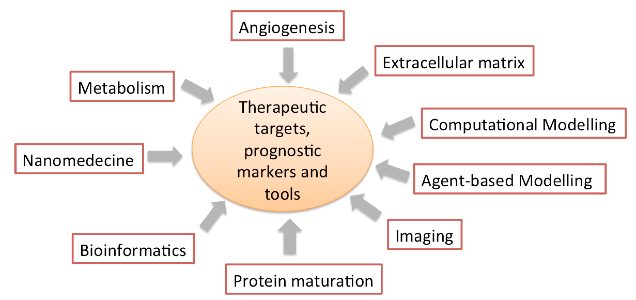Intercellular COMMUnication in CANcer biology and Therapy
Description: The aim of this proposal is to understand how intra-tumor inter-cellular communication takes place and impacts the disease outcome, to explore the contribution of these interactions to the failure of presently available treatments, and to investigate novel strategies based on a 3D view of tumor tissues rather than on a simple pathway targeting. The aim is to intervene at the level of the tumor logistics in order to weaken the cancer and increase its sensitivity to therapy. The final objective of this comprehensive approach of tumor physiopathology is to increase the survival of patients by acting on the tumor microenvironment to mitigate the limitations of traditional treatment approaches.
LCPO Team 3 is involved in work-package 3 “Development of nanomedicines in preclinical settings” dedicated to the formulation of nanomedicines as tools to target specific biomarkers and investigate critical signaling pathways identified by biologists, or as relevant drug delivery therapeutics for the treatment of gliomas, colon or kidney carcinomas for clinical translation. This WP thus includes specific tasks dedicated to the design of nanomedicines as well as to the development of screening assays using in vitro models (spheroids) and in vivo experiments (in mice). LCPO Team 3 will design multifunctional polymer nanoparticles combining targeting, imaging and/or therapeutic properties and serve either as tools to investigate specific biological pathways involved in tumor progression or as alternative targeted therapeutics with reduced side-effects. Two collaborative projects have started with specific goals. The first project is to develop and evaluate polymer nanoparticles targeted to the CXCR3 chemokine receptor. A potent antagonist is therefore attached to the hydrophilic chain end of PTMC-b-PEO block copolymers, labeled with an NIR dye. The surface of resulting self-assembled polymersomes exhibit multivalency effect. Their biological effects are studied using model cell lines transfected with either the CXCR3-A or the CXCR3-B receptor isoform, which have opposite effect in cancer progression. The downstream signaling of the receptors (pERK), calcium efflux, nanoparticles internalization, and cell migration are in particular examined. (Project funded by La Ligue contre le Cancer). A second project lies in the development of polymeric vesicles dually loaded with paramagnetic manganese complex and NIR dye to study the triggered-release of encapsulated drug under the pH variation stimulus in the tumor environment. Thanks to this dual labelling, the polymersome biodistribution will be performed by two complementary imaging techniques, namely optical imaging and MRI. The final aim is to follow the permeabilization of these drug carriers using both imaging modalities. Preclinical evaluation of these systems will be done at the Viv’Optic in vivo optical imaging platform in Bordeaux and at the Center for Microscopy & Molecular Imaging (CMMI) in Belgium.
Partners: Angiogenesis and Cancer Microenvironment Laboratory (INSERM U1029), Molecular Imaging and Innovative Therapies (IMOTION, EA7435 Univ Bordeaux), NMR and Molecular Imaging Laboratory (UMONS, Belgium)

